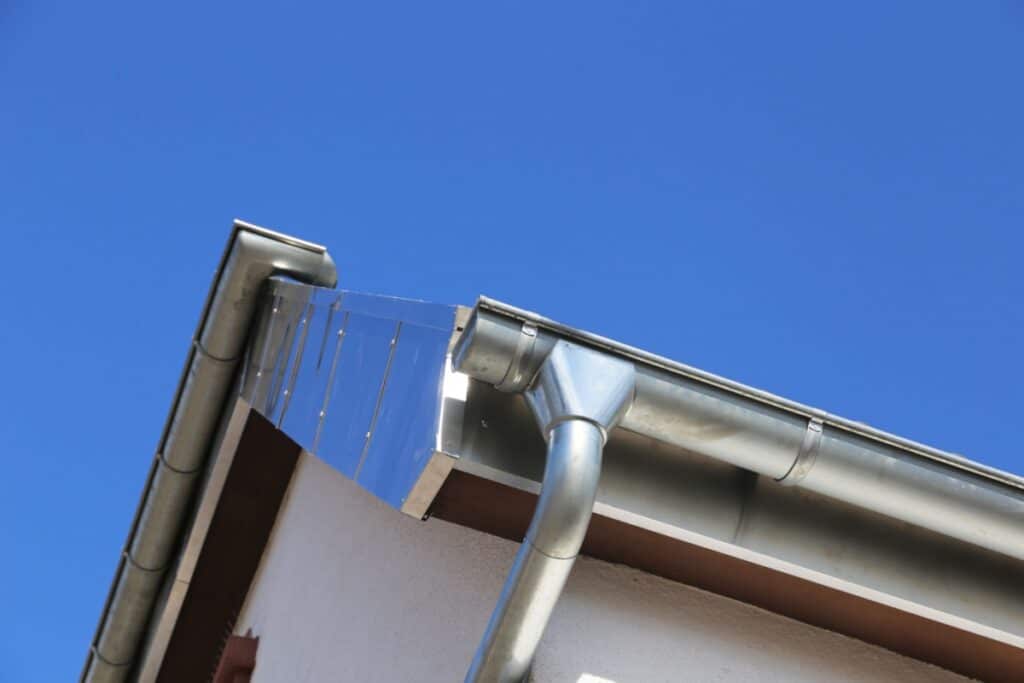Gutter flashing is a crucial part of any roofing system. It prevents water damage and ensures your gutters work correctly. But what is gutter flashing, and why is it so important? Let’s dive in and explore everything you need to know about gutter flashing, its importance, and the installation process.
The Basics: What is Gutter Flashing?
So what is gutter flashing, exactly? Great question! Gutter flashing is a thin strip of material, typically aluminum or galvanized steel, installed along the roof of a house where the roof shingles meet the gutters. Although you may not know much about your home’s gutter flashing, important work is taking place right above your head as your flashing helps prevent water from destroying your home’s structure, one rainstorm at a time!
The primary function of gutter flashings is to guide rainwater off your roof and into your gutters. Even though the space between your shingles and your gutters may seem airtight, even very small holes can allow water to seep in during rain or wind storms, eventually causing structural damage to your home’s exterior walls, roof, and other vulnerable areas. If your home is built without gutter flashing or your flashing isn’t working correctly, your gutters can’t effectively prevent water from pooling on your roofing system, which can quickly turn into a big problem.
Types of Gutter Flashing
Several types of gutter flashing exist, each serving a specific purpose. The most common kinds of gutter flashings include:
Drip Edge
A drip edge is another name for metal gutter flashing installed along the roof edge. It directs water away from the fascia and into the gutters, protecting the roof’s edge and fascia boards from water damage. In contemporary homes, the aluminum drip edge is typically installed when the roof is first built. However, we can also set up this type of gutter flashing during gutter installation or gutter repair.
Gutter Apron
A gutter apron is a type of flashing installed under the roof shingles and over the back of the gutter. When working correctly, it prevents water from seeping behind the gutter and causing damage to the roof decking and fascia. The gutter apron is an important part of a properly functioning gutter system, whether you live in an old building or a brand-new house.
Simple Gutter Flashing
This type of gutter flashing is a straightforward, cost-effective solution to direct water into the gutters. It’s typically placed along the roof line during gutter installation, covering any gaps between the roof and the rain gutters. Simple flashing is easy to install and maintain.
The Installation Process: How to Install Gutter Flashing
Installing gutter flashing is a job best left to our talented professionals at Aho Seamless Gutters. However, understanding how installation works can help homeowners appreciate the importance of this crucial component. Here’s how we tackle gutter installation in Worcester, MA, and nearby New England areas:
Step 1: Preparing the Roof
Before installing gutter flashing, the roof must be clean and free of debris. This step is arguably the most important part, as it ensures that the flashing adheres properly and provides a secure seal.
Step 2: Measuring and Cutting the Flashing
The next step involves measuring the roof’s edge and cutting the metal flashing to the correct length. The flashing must hang slightly beyond the roof to provide adequate cover against wind, rain, and snow.
Step 3: Installing the Flashing
Once the flashing is cut to size, it’s installed along the roof’s edge using roofing nails. The flashing should be positioned so that it directs water into the gutters and prevents it from seeping behind the gutter system.
Step 4: Securing the Flashing
After positioning the gutter flashing, we secure it in place using additional nails. The nails must be placed at regular intervals to ensure the flashing remains firmly in place, even in strong winds and heavy rain.
Step 5: Ongoing Gutter Maintenance
Maintaining your gutter flashing is essential to ensure it continues to protect your roof, walls, and siding. Regular inspections can help us repair potential problems with your flashing before they become serious. Have our team check your gutter flashing at least twice a year, preferably in the spring and fall. Look out for signs of rust, damage, or loose flashing, and give us a call ASAP for gutter repair if you think something seems off.
Benefits of Gutter Flashing
Gutter flashing offers numerous benefits to homeowners, including:
Protection Against Water Damage
Gutter flashing prevents water from seeping behind the gutters, protecting the fascia, soffit, and walls from water damage. This can extend the life of the building materials and reduce the need for costly roofing and siding repairs.
Improved Gutter Performance
By enabling excess water to flow into the gutters, gutter flashing prevents overflow and reduces the risk of gutter issues such as clogs and leaks.
Enhanced Home Aesthetics
Having gutter flashing installed can also improve the appearance of your home by providing a clean, finished look along the roof. This enhancement can increase curb appeal and add value to the property.
Get Educated About Your Gutters!
Understanding what gutter flashings are and how they protect against water damage is an important part of maintaining the structural integrity of your property. If you’re experiencing gutter flashing issues, need gutter repairs, or want to install gutter toppers, contact Aho Seamless Gutters for a free inspection. Our experienced team can ensure your entire gutter system is installed correctly and provide expert gutter repair and maintenance services to keep your home safe and dry. We’re looking forward to hearing from you!




